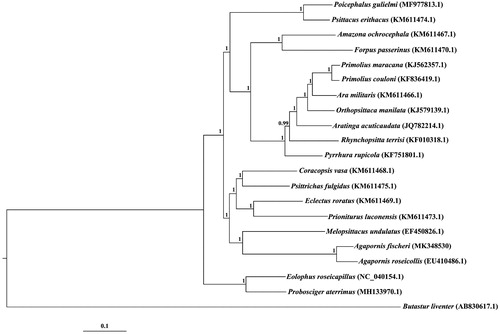Abstract
Fischer's Lovebird (Agapornis fischeri) is one of the most popular pet birds in the world. Here, we first reported the complete mitochondrial genome of this species. Its mitochondrial genome is a circular molecule of 16,719 bp in size, and all genes exhibit the typical gene arrangement according with most avian consensus. The overall base composition is 51.1% A + T and 48.9% G + C. Bayesian tree suggested that A. fischeri was placed as sister to the Agapornis roseicollis of the same genus. The results obtained here would be useful for phylogenetic analyses and breeding works of A. fischeri in future.
Fischer's Lovebird (Agapornis fischeri) is native to north-central Tanzania and introduced to other African nations, such as Burundi, Kenya, and Rwanda (Cunningham-van Someren GR 1975; IUCN Citation2018). This species inhabits all types of woodland, especially semi-arid woodland of Acacia, Adansonia, and Commiphora (Mwangomo et al. Citation2008; Soobramoney and Perrin Citation2014). It was once the most popular wild-caught parrot in the world and the most common bird in the wild animal trade (Mwangomo et al. Citation2008; Li and Jiang Citation2014). This species is now being bred in captivity for the pet trade (Frynta et al. Citation2010; IUCN Citation2018). It has hybridized with other Agapornis species in the wild and in captivity (Buckley Citation1969; IUCN Citation2018). Hybrid parrots are very marketable due to their novel and colourful feathers (van der Zwan et al. Citation2018). Here, we described the complete mitochondrial genome of A. fischeri.
Muscle tissue of a dead bird was collected from the Nanjing Hongshan Forest Zoo, Jiangsu Province of China (N 32° 09′, E 118° 80′). The specimen was stored in the College of Biology and the Environment, Nanjing Forestry University. Genomic DNA was extracted using the DNAiso reagent (Takara, Beijing, China). Polymerase chain reaction was carried out by the Ex Taq (Takara, Beijing, China). Sanger sequencing was performed to obtain genome information. The complete mitochondrial genome of A. fischeri is a typical circular DNA molecule with 16,719 bp in size (GenBank accession: MK348530). The nucleotide composition is 21.5% T, 34.6% C, 29.6% A, 14.3% G, with A + T content of 51.1%. There are 22 transfer RNA genes, 13 protein-coding genes, two ribosomal RNA genes, and a non-coding control region in the mitochondrial genome. The gene arrangement in the mitochondrial genome of A. fischeri is identical to other lovebird, which is the original mitochondrial gene arrangement in avian species (Boore Citation1999; Eberhard and Wright Citation2016).
Twenty parrot species were used to reconstruct phylogenetic tree based on the complete mitochondrial genome through the Bayesian inference method (Huelsenbeck et al. Citation2001), using Butastur liventer as an outgroup. Phylogenetic tree showed that A. fischeri is placed as sister to the Agapornis roseicollis of the same genus (). Besides, the Agapornis parrots are closely related to Melopsittacus undulates distributed in the Australian outback (). The genome information obtained here could contribute to the conservation and utilization of A. fischeri.
Disclosure statement
No potential conflict of interest was reported by the authors.
Additional information
Funding
References
- Boore JL. 1999. Animal mitochondrial genomes. Nucleic Acids Res. 27:1767–1780.
- Buckley PA. 1969. Disruption of species-typical behavior patterns in F1 hybrid Agapornis parrots. Ethology. 26:737–743.
- Cunningham-van Someren GR. 1975. Agapornis fischeri Reichenow in Kenya? AUK. 92:370–371.
- Eberhard JR, Wright TF. 2016. Rearrangement and evolution of mitochondrial genomes in parrots. Mol Phylogenet Evol. 94:34–46.
- Frynta D, Lisková S, Bültmann S, Burda H. 2010. Being attractive brings advantages: the case of parrot species in captivity. PLoS One. 5:e12568.
- Huelsenbeck JP, Ronquist F, Nielsen R, Bollback JP. 2001. Bayesian inference of phylogeny and its impact on evolutionary biology. Science. 294:2310–2314.
- International Union for Conservation of Nature (IUCN). 2018. The IUCN red list of threatened species. Agapornis fischeri. Brussels, Belgium: IUCN; Version 3.1. [accessed 2018 Oct 22]. http://www.iucnredlist.org.
- Li LL, Jiang ZG. 2014. International trade of CITES listed bird species in China. PLoS One. 9:e85012.
- Mwangomo EA, Hardesty LH, Sinclair ARE, Mduma SAR, Metzger KL. 2008. Habitat selection, diet and interspecific associations of the rufous-tailed weaver and Fischer's lovebird. Afr J Ecol. 46:267–275.
- Soobramoney S, Perrin M. 2014. A comparison of the alarm calls of five species of African lovebirds: genus Agapornis. T Roy Soc S Afr. 69:9–18.
- van der Zwan H, van der Westhuizen F, Visser C, van der Sluis R. 2018. Draft de novo genome sequence of Agapornis roseicollis for application in avian breeding. Anim Biotechnol. 29:241–246.

